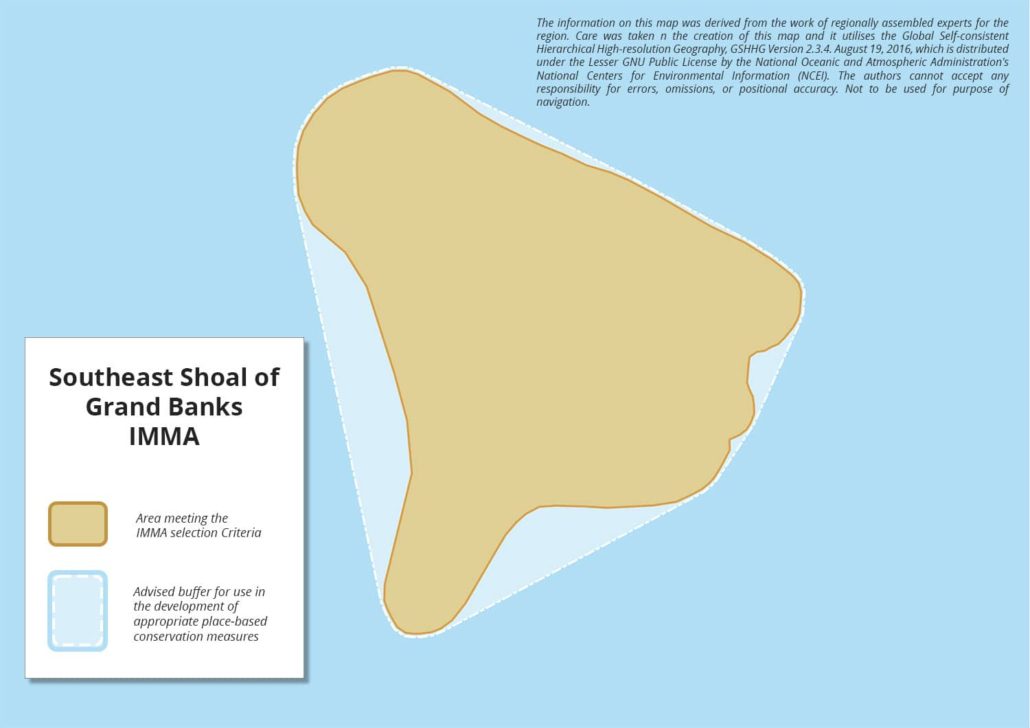Southeast Shoal of Grand Banks IMMA
Size in Square Kilometres
11,593
Qualifying Species and Criteria
Humpback Whale – Megaptera novaeangliae
Criterion B (2); Criterion C (2)
White-beaked dolphin – Lagenorhynchus albirostris
Criterion B (2); Criterion C (2)
Criterion D (2) – Marine Mammal Diversity
Other Marine Mammal Species Documented
Balaenoptera acutorostrata, Balaenoptera physalus, Delphinus delphis, Globicephala melas, Leucopleurus acutus, Orcinus orca
Summary
The Southeast Shoal IMMA is located about 370 km from the island of Newfoundland, in the southeastern part of the Grand Banks. It is defined by a sandy rise on the floor of the Grand Banks about 40-55 m below the water surface, and is the only major offshore area of spawning for the fish capelin (Mallotus villosus) in the western North Atlantic. While the capelin are spawning it is a major feeding area for humpback whales (Megaptera novaeangliae), and also seems to be a significant foraging area for white-beaked dolphins (Lagenorhynchus albirostris). The area encompasses part of the “Southeast Shoal and Adjacent Areas on the Tail of the Grand Bank” EBSA due to its importance as a feeding area for cetaceans and seabirds.
Description of Qualifying Criteria
Criterion A – Species or Population Vulnerability
Criterion B – Distribution and Abundance
Sub-criterion B1 – Small and Resident Populations
Sub-criterion B2 – Aggregations
Substantial aggregations of humpback whales (Megaptera novaeangliae) and white-beaked dolphins (Lagenorhynchus albirostris) have been documented on the Southeast Shoal of the Grand Banks during the capelin spawning period in June-July (Whitehead and Glass 1985a). Photo-identification surveys in 1982 and 1983 estimated that about 900 humpback whales used the shoal, about 15-30% of the humpback whale population in the Northwest Atlantic at that time (Whitehead and Glass 1985a). Some of the humpback whale groups observed were exceptionally large (over 40 animals; Whitehead and Glass 1985a). Cetacean sightings records collected from a variety of sources and collated by Fisheries and Oceans Canada over the past 80+ years show that a variety of cetacean species occur in this general area, and this area is predicted to be potentially important habitat for both humpback whale and white-beaked dolphins in a recent Species Distribution Modelling study (Gomez et al. 2020).
Criterion C: Key Life Cycle Activities
Sub-criterion C1 – Reproductive Areas
Sub-criterion C2: Feeding Areas
Many marine predators off Newfoundland depend on the small fish capelin (Mallotus villosus) as primary sustenance (e.g. Whitehead and Carscadden 1985 for baleen whales). Capelin are particularly aggregated and slow moving when they spawn. Most capelin spawn along the shoreline but, unusually, there is a large spawning aggregation on the Southeast Shoal (Carscadden 1976). This seems to be an important source of nutrition for humpback whales (and probably white-beaked dolphins), whose distributions were highly correlated with the presence of sonar traces of capelin schools (Whitehead and Glass 1985a). Although this area has not been the focus of more recent cetacean surveys, it is assumed that these feeding aggregations persist.
Sub-criterion C3: Migration Routes
Criterion D – Special Attributes
Sub-criterion D1 – Distinctiveness
Sub-criterion D2 – Diversity
Supporting Information
Carscadden, J.E., 1978. The capelin, Mallotus villosus, population spawning on the Southeast Shoal of the Grand Bank, 1976. Int. Comm. Northwest Atl. Fish. Sel. Pap, 3: 61-71.
Convention on Biological Diversity (CBD) 2014. Report of the North-West Atlantic regional workshop to facilitate the description of ecologically or biologically significant marine areas. UNEP/CBD/EBSA/WS/2014/2/4.
Coughlan, G.P., 2002. The Southeast Shoal area of the Grand Banks of Newfoundland. Potential as a marine protected area: A biophysical and socio-economic area examination. (Master’s thesis, University of Calgary, Calgary, Canada).
Gomez, C., Konrad, C.M., Vanderlaan, A., Moors-Murphy, H.B., Marotte, E., Lawson, J., Kouwenberg, A-L., Fuentes-Yaco, C., Buren, A. 2020. Identifying priority areas to enhance monitoring of cetaceans in the Northwest Atlantic Ocean. Can. Tech. Rep. Fish. Aquat. Sci. 3370: vi + 103 p.
Whitehead, H. and Carscadden, J.E. 1985. Predicting inshore whale abundance – whales and capelin off the Newfoundland coast. Canadian Journal of Fisheries and Aquatic Sciences 42: 976-98
Whitehead, H. and Glass, C., 1985a. The significance of the Southeast Shoal of the Grand Bank to humpback whales and other cetacean species. Canadian Journal of Zoology, 63(11): 2617-2625.
Whitehead, H. and Glass, C. 1985b. Orcas (killer whales) attack humpback whales. Journal of Mammalogy 66: 183-185.
Downloads
Download the full account of the Southeast Shoal of Grand Banks IMMA using the Brochure button below:
To make a request to download the GIS Layer (shapefile and/or geojson) for the Southeast Shoal of Grand Banks IMMA please complete the following Contact Form:



